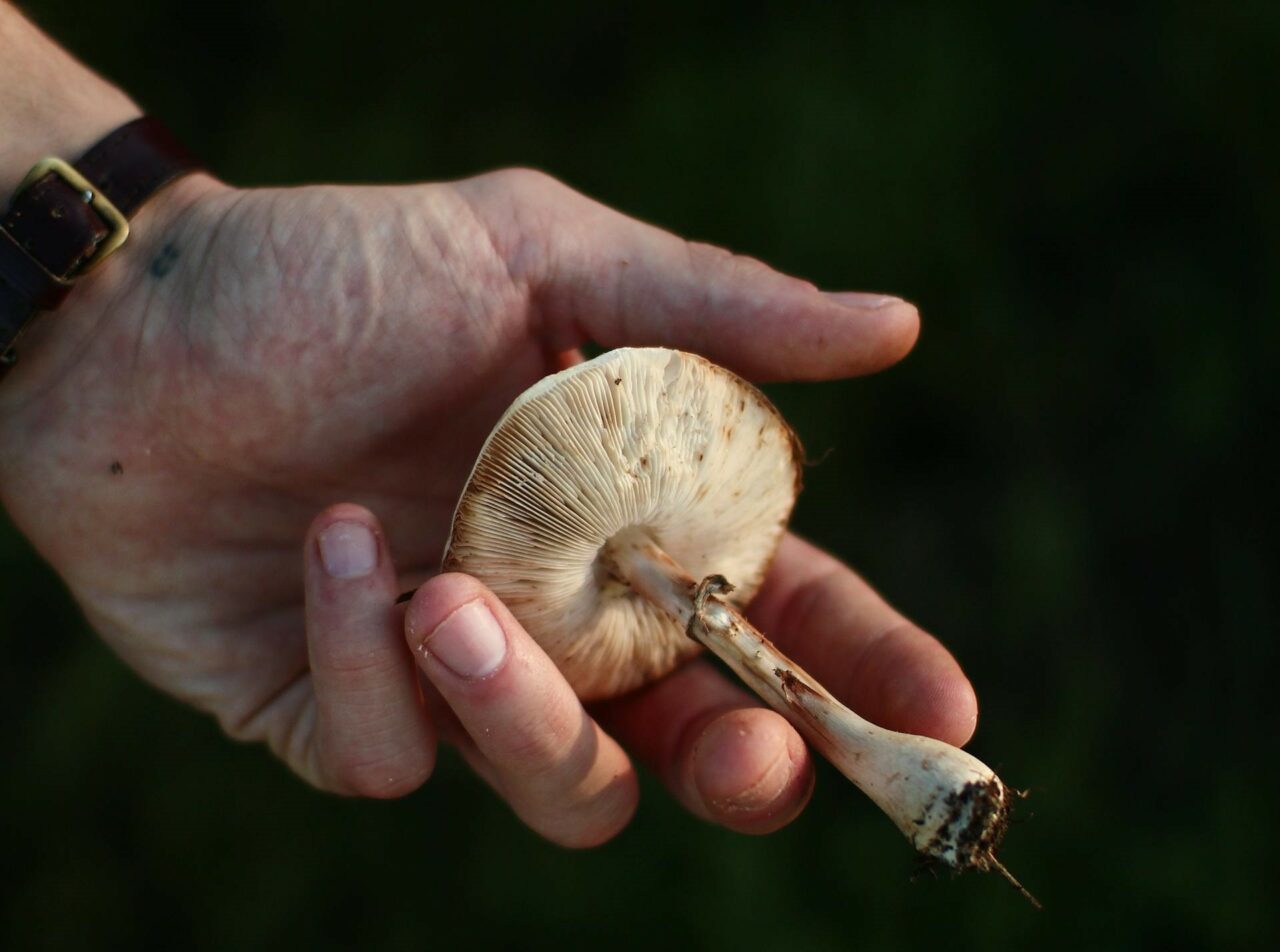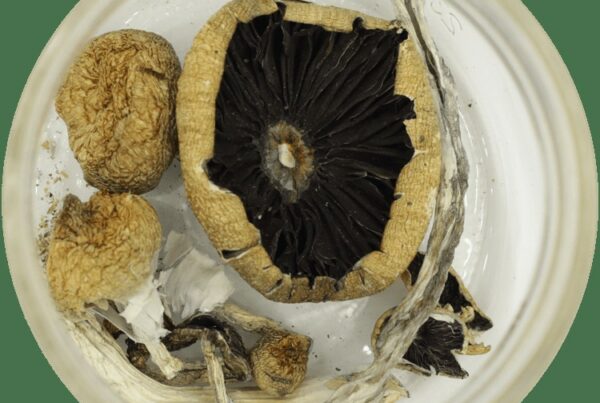Known as traditional psychedelics, Psilocybin mushrooms function similarly to LSD, acting as a serotonin 5-HT2A receptor agonist. Current research is exploring their use in psilocybin-assisted therapy for mental health disorders. These include the emotional distress linked with severe depression, anxiety, cluster headaches, and migraines.
To understand how shrooms can benefit these conditions, it’s vital to learn how the body metabolizes them. This knowledge enables both researchers and users to comprehend how the active compound produces psychological and therapeutic effects. This article offers a basic explanation of psilocybin’s pharmacology and pharmacokinetics.
[toc]
Key Points:
- Once orally consumed, half of the psychedelic fungi is absorbed and distributed across the body.
- Primarily in the liver, the fungi compound undergoes a process called dephosphorylation, which is facilitated by the enzyme alkaline phosphatase.
- About 3.4% of the compound is expelled in its initial form within 24 hours, while the rest is mainly excreted as a stable metabolite.
What Does Pharmacokinetics Mean?
Pharmacokinetics (PK) refers to the study of how substances, like drugs, are processed by the body after intake. It’s a distinct yet related field to pharmacodynamics, which focuses on how a compound interacts with the body. PK investigates four main aspects: absorption, distribution, metabolism, and excretion (ADME).
Comprehending these processes equips healthcare professionals to prescribe the most suitable medications with the lowest possible risk. It also empowers them to customize treatments based on each patient’s individual physiology and lifestyle.
How is Pharmacokinetics Relevant to Psilocybin?
Psilocybin and psilocin, the main active compounds in certain magic mushroom species, have captivated considerable interest among researchers and users. Pharmacokinetics studies how the body manages ingested mushrooms containing psilocybin, facilitating a better understanding of their potential effects, whether for medicinal or recreational purposes.
These compounds are known by various names, including “magic,” “psychedelic,” “medicinal,” or “sacred.” The fungi containing these compounds are consumed, with The mushroom species, their source, size, the conditions in which they grow and are processed, as well as their age, can greatly influence their levels of concentration.
Although these mushrooms are naturally found in the wild, scientists have devised ways to create them synthetically in the lab. Both naturally occurring and synthetic versions have low toxicity, but they may cause minor side effects such as nausea or vomiting.
Despite the physical effects, the compounds within these mushrooms have demonstrated potential therapeutic benefits due to their safe profile and non-addictive nature. This has motivated researchers to explore their use in psychotherapy, particularly as a treatment for anxiety and depression.
The Four Stages of Pharmacokinetics
Psilocybin, the compound present in these mushrooms, is inactive in its original form and serves as a prodrug, converting into its active form, psilocin. Alkaline phosphatase and other enzymes facilitate this transformation, enabling psilocin to be absorbed and distributed throughout the body to reach different tissues. However, after oral intake, psilocybin cannot be detected in the circulatory system, feces, or urine.
Absorption
Absorption refers to the process where the compound enters the bloodstream from the site of administration. This process affects the speed and effectiveness with which the compound reaches its intended target, such as plasma. Oral intake is the most commonly used method of administration. Inhalation has been experimented with, but it is less effective than ingestion.
The absorption process also entails the release of the compound from the dosage form during oral consumption. Factors like delay in the throat or esophagus can impact this, potentially slowing down effects or causing discomfort. When the compound reaches the stomach, the acidic environment may start to degrade it before it enters the bloodstream.
Studies on animals suggest that approximately 50% of orally administered psychedelics are absorbed and distributed throughout the body.
Factors Affecting the Absorption Process
A variety of factors can influence the absorption process, leading to variations in the onset, intensity, and duration of effects:
- Stomach Contents: Having a full stomach can delay absorption because it slows down the onset of effects. Absorption is faster on an empty stomach.
- Body Fat: Substances can accumulate in adipose tissue, potentially prolonging their effects.
- Age: Metabolic rates and body composition may vary with age.
- Zero-Order Kinetics: The substance is eliminated at a steady rate, regardless of its concentration.
- First-Order Kinetics: The rate of substance removal is directly proportional to its concentration.
The phosphate group in psilocybin displays strong polarity. Combined with the positive charge of the amine group, this results in the molecule being zwitterionic and increases its solubility in water compared to psilocin. Without the phosphate group, psilocin becomes more soluble in lipids, more accessible metabolically, and is absorbed more readily in the intestines.
class=”wp-block-heading”>Dissemination“Dissemination” refers to how psilocin spreads throughout the body once it’s entered the bloodstream. Because it’s lipophilic, psilocin can traverse the blood-brain barrier, eventually reaching the central nervous system.
system.Various factors such as the size, polarity, and protein-binding ability of the substance, coupled with a person’s physiological characteristics—including hydration status and body composition—significantly impact this process.
The aim is to achieve an effective concentration at the target location. For efficacy, the substance must not only reach the intended area, as determined by the volume of distribution, but also remain unbound to proteins, enabling active interaction with its receptor.
What Factors Can Affect the Dissemination Process?
The dissemination process can be affected by a variety of factors:
Effects typically begin to manifest between 20-40 minutes after consumption, reaching their peak at approximately 80-100 minutes. The effects of magic mushrooms generally endure for a period of 4-6 hours.
How Does Dissemination to the Brain Happen?
An initial experimental study on two species indicated that its binding affinity sequence is 5HT2A > 5HT1A > 5HT2B [23]. It also attaches to dopamine D1, 5HT1E, 5HT5A, 5HT7, 5HT6, D3, 5HT2C, and 5HT1B receptors.
It acts as a partial agonist at the 5HT2A receptor, with an efficacy of approximately 40%. The psychedelic effects can be attributed to its partial agonist activity at 5HT1A autoreceptors.
The mood-enhancement and psychotomimetic experiences may stem from the observed correlation between increased dopamine levels and sensations of depersonalization and euphoria. Hallucinogens work by modifying neurochemistry and receptor activity. It enhances 5HT2A agonist activity by boosting BDNF synthesis in the hippocampus, which in turn encourages neurogenesis and reduces conditioned fear-related behaviours.
Elimination
Elimination refers to the process by which the
The body excretes substances primarily through the kidneys, but also through the lungs, skin, or gastrointestinal tract. As for the kidneys, they filter or secrete a naturally occurring psychedelic drug in the glomerulus or tubules, respectively. The process is further complicated by some reabsorption.
The main substance has a half-life of roughly 160 minutes, whereas psilocin’s half-life is close to 50 minutes. Animal studies suggest that the majority of this substance is excreted through urine, accounting for about 65% within 8 hours of intake. Even after consumption, traces of the substance can still be detected in lesser quantities in the bile and feces.
In the human body, about 3.4% of the substance is expelled in its original form within 24 hours. However, the majority is eliminated as psilocin-O-glucuronide, a more stable metabolite. This stability allows the substance to be identified in urine samples for an extended duration.
Substances are primarily excreted in two ways:
Most psychedelic drugs are eliminated following the first-order kinetics method, reaching a constant concentration after about four to five half-lives. Complete elimination also occurs after approximately four to five half-lives.
Discover Our Range of Hallucinogenic Mushrooms
The metabolic process varies among different types of fungi. By purchasing from reliable online vendors such as Magic Mushrooms Ottawa Canada, you can avoid inadvertently consuming poisonous mushrooms. Certain types, like Agaric mushrooms, can produce strong and undesirable effects. It is therefore critical to buy magic mushrooms from trustworthy sources, rather than risky street dealers or wild foraging.
| Feature | Enigma | Full Moon Party | Gold Member | |
| Strain Type | Psilocybe Cubensis OMNI | Psilocybe cubensis (Thai Koh Samui) | Psilocybe cubensis | |
| Potency | Exceptionally high; 3.8% tryptamine content | Moderate to high potency | High potency | |
| Visual Characteristics | Resembles a blob or | Resembling a cauliflower or brain in structure | Appears traditional for cubensis, moderate in size | Thick stems in white; caps in golden caramel; evident blue bruising |
| Effects | Known as the most potent, generating intense effects | Produces strong mental high; onset is delayed with notable visuals | Highly potent visuals and euphoria |
Online Learning about Psilocybin Mushroom Usage
For medical professionals, researchers, and users, it’s crucial to understand the pharmacokinetics of shrooms. Armed with this knowledge, you can make informed decisions about dosage and timing, thereby reducing potential risks.
Discover your perfect psychedelic experience at Magic Mushrooms Ottawa Canada. Whether you’re after a soothing journey or a deeper exploration, we’ve designed our diverse product range to meet your specific needs. Enjoy top-quality, safe, and controlled shrooms, eliminating worries about unreliable sources or toxic mushrooms.
Try out the best magic mushrooms Canada can provide and take your psychedelic journey to new heights.
Frequently Asked Questions
Do shrooms interact with other medications?
Our products might interact with some medications, particularly those that affect serotonin levels, such as SSRIs (Selective Serotonin Reuptake Inhibitors). SSRIs and SNRIs (Serotonin and Norepinephrine Reuptake Inhibitors) could reduce the effects, unlike non-serotonergic antidepressants. This reduced effect may last for up to three months after discontinuing the antidepressant.
Do all psychedelics work the same way as psilocybin?
No, each psychedelic substance has a unique structure that requires different metabolic processes to activate, and they bind to various receptors in the body. The method of administration also affects the absorption of each psychedelic. While the basic principles of absorption, metabolism, and distribution remain the same, each substance has unique pathways and effects.
Does the form of the mushroom affect the pharmacokinetics?
Yes, the form (whether fresh, powdered, or dried mushrooms) can affect the rate of absorption. For example, powdered forms may be absorbed faster than whole dried ones due to quicker dissolution.
Additional Reading:





